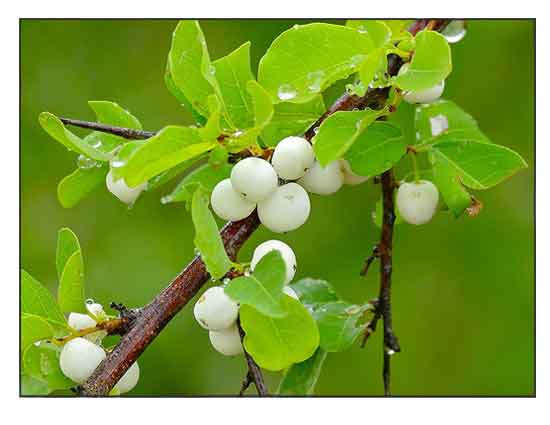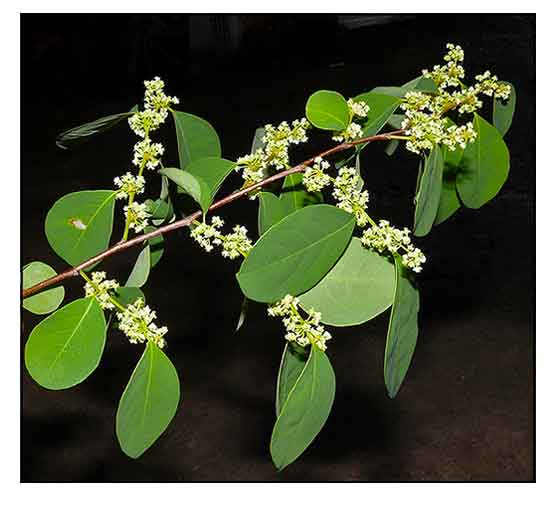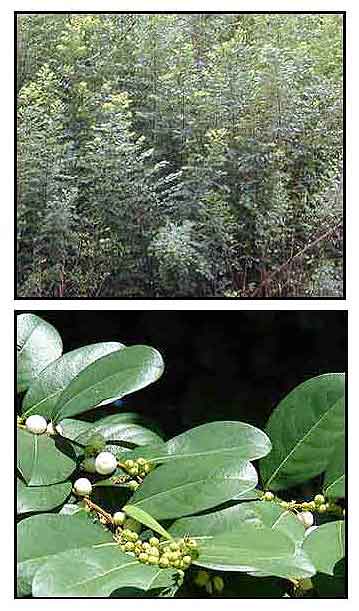 Gen info Gen info
- The genus Flueggea, the bushweeds, is a genus of shrubs and trees in the family Phyllanthaceae (previously Euphorbiaceae), first described as a genus in 1806. The genus consists of 12-16 species.
- The genus name Flueggea honors John Flüeggé (1775-1816), a German cryptogamic botanist. (4)
- There is evidence that suggests its ancient roots: A digging stick made of Flueggea virosa, dated about 24,000 BP, was found in Border Cave, South Africa. (37)
Botany
• Botolan is a deciduous, smooth, graceful, small to large much-branched shrub, 1 to 3 meters high, occasionally a tree 7 meters high. Leaves are extremely variable in shape, elliptic-ovate, obovate or orbicular, 2.5 to 10 centimeters in length, rather glaucous beneath, and rounded, obtuse or pointed at the tip. Flowers are usually borne on axillary fascicles. Fruit is mostly small, black or white, dry, and about 3 to 5 millimeters in diameter, edible and sweet.
 Distribution Distribution
- Native to the Philippines.
-
In dry thickets at low and medium altitudes.
- Also native to Andaman Is., Angola, Assam, Bangladesh, Benin, Borneo, Botswana, Burkina, Burundi, Cambodia, Cameroon, Caprivi Strip, Central African Repu, Chad, China North-Central, China South-Central, China Southeast, Comoros, Djibouti, East Himalaya, Egypt, Eritrea, Ethiopia, Gambia, Ghana, Guinea, Guinea-Bissau, India, Ivory Coast, Jawa, Kenya, KwaZulu-Natal, Lesser Sunda Is., Madagascar, Malawi, Malaya, Mali, Maluku, Mauritania, Mozambique, Mozambique Channel I, Myanmar, Namibia, Nepal, New Guinea, Nicobar Is., Nigeria, Northern Provinces, Northern Territory, Oman, Queensland, Rwanda, Réunion, Saudi Arabia, Senegal, Sierra Leone, Socotra, Somalia, South China Sea, Sri Lanka, Sudan, Sulawesi, Sumatera, Swaziland, Taiwan, Tanzania, Thailand, Togo, Uganda, West Himalaya, Western Australia, Yemen, Zambia, Zaïre, Zimbabwe. (24)
Constituents
- Bark contains 10% tannic acid and an alkaloid.
- There are three main categories of phytochemicals isolated from F. virosa: polyphenols (bergenin as lead product); terpenoids (flueggenoids and related podocarpane-type diterpenoids); and many alkaloids derived from securinine and norsecurinine. (37)
-
Phytochemical screening of methanol extract of leaves yielded reducing sugars, cardiac glycosides, resin, tannins, saponins, glycosides, flavonoids, glycerin carbohydrate, anthraguine and steroids. (2)
 - Phytochemical screening of aqueous extract of dried root
yielded saponins, tannins, cardiac glycosides, and steroids. - Phytochemical screening of aqueous extract of dried root
yielded saponins, tannins, cardiac glycosides, and steroids.
- Study of leaves and twigs isolated friedelin (1), epifriedelanol (3), stigmasterol (4) and betulinic acid (5). (see study below) (17)
- Ethanol extract of root bark
yielded polyterpenes, alkaloids. Total aqueous extract yielded polyterpenes, polyphenols, flavonoids, catechin, tannins, quinone substances and alkaloids. (18)
- Study of leaves and twigs yielded 11-O-acetyl bergenin (1), bergenin (2), virosecurinine (3), ent-phyllanthidine (4), kaempferol (5), quercetin (6), gallic acid (7), daucosterol (8) and β-sitosterol (9). (21)
- Phytochemical screening of ethanol leaf extracts yielded tannins, saponins, phenols, alkaloids, flavonoids, carbohydrates
and cardenolide. (see study below) (27)
- Study of twigs and leaves yielded a new terpenoid, 9(10→20)-abeo-ent-podocarpane, 3β,10α-dihydroxy-12-methoxy-13- methyl-9(10→20)-abeo-ent-podocarpa-6,8,11,13-tetraene (1), along with five known compounds (2-6). Also, the structure of dehydrochebulic acid trimethyl ester was revised as (2S,3R)-4E-dehydrochebulic acid trimethyl ester. (see study below) (28)
- Study of leaves of Securinega virosa isolated two cytotoxic alkaloids, virosecurinine (1) and viroallosecurinine (2). (see study below) (1)
- Study of methanolic root extract of Flueggea virosa characterized 18 non-alkaloid terpenoids: six rearranged ent-podocarpanes, 11 ent-podocarpanes, and a novel 3,4-seco-30-nor-friedelane. (see study below) (40)
- Phytochemical screening of leaf extracts of F. virosa showed the presence of alkaloids, flavonoids, saponin, steroids, tannins, terpenes, cardiac glycosides, anthraquinones, and reducing sugars. (see study below)
(43)
- Study of fruits isolated three new indole alkaloids, flueindolines A-C (1-3), along with nine known alkaloids (4-12). (44)
- Study of twigs and leaves isolated four new securinega-type alkaloids, fluevirines A-D (1-4) along with ten known ones. (see study below) (46)
Properties
- Bark is astringent and considered poisonous.
- Considered aphrodisiac, antidotal, laxative, wound healing.
- Studies have shown antimalarial, antioxidative, analgesic, antimalarial, anti-inflammatory, antidiabetic, cytotoxic, sedative properties.
Parts used
Roots, leaves, wood, juice.
 Uses Uses
Edibility
- Fruit is edible.
- White fruit reportedly eaten in East Africa.
Folkloric
- In the Rizal Province in the Philippines, charcoal of the wood is powdered and used as cicatrizant of wounds. Decoction of leaves used for cleaning wounds.
- Juice of leaves of paste of leaves with tobacco used to destroy worms in sores.
- Decoction of leaves used as laxative.
- Root, sometimes with the leaves, taken for venereal disease.
- In tropical Africa, used alone or in combination with other plants fir a variety of maladies, including liver, kidney, urinary and venereal diseases, bile deficiency, testicular inflammation, frigidity, sterility, menorrhagia, rheumatism, and arthritis. (38)
- In traditional African medicine, used in the treatment of epilepsy. (26)
- In tropical Africa, used as remedy for diarrhea. Root decoction given as drink to calm children and to help them sleep.
- In Rhodesia, roots used as aphrodisiac.
- In Tanzania, used as aphrodisiac and treatment of impotence. (25)
- In south-central Zimbabwe, all plant parts used to treat frigidity, liver, bile, kidney, testicular inflammation, sterility, urinary and venereal diseases. Root extract drunk for treatment of pneumonia; drunk as contraceptive before sexual intercourse. Dried root powder applied to snake bites; root powder applied to wounds. (14)
- In West Ashantis, root used for gonorrhea.
- In Tanzania and West Africa, used for malaria.
- In Western Uganda, roots and leaves used for sexual impotence and erectile dysfunction.
- Ewe people of Togoland used decoction of leaves internally for constipation.
- In Kenya, roots used for malaria; root bark used for chest pains.
- In Northern Nigeria, root decoction used for treatment of mental illness.
- In Mali, root extract used to treat bilharziasis (schistosomiasis): Fresh roots are crushed and boiled to prepare a drinkable solution. Plant also used for the treatment of benign prostatic hyperplasia.
Others
- Tanning / Dye: Bark is used for tanning and as a black dye for matting. Leaves also used for staining.
- Fuel: Makes a good fuel wood.
- Timber: Valued for use in houses and fence posts; as joists, rafters, and tool handles.
- Repellent: Pounded leaves used as insect repellent.
Studies
• Cytotoxic Alkaloids / Leaves: Study of leaves of Securinega virosa isolated two cytotoxic alkaloids, virosecurinine and viroallosecurinine. Study of compound 1 for cytotoxicity and its derivatives showed an α,β‐ and a γ,δ‐unsaturated lactone located in a strained ring system, such as rings ‐B, ‐C, and ‐D of 1, is structurally required for significant cytotoxicity. (1)
• Anti-Diabetic / Leaves / Roots: Study of a methanol extract of Securinega virosa leaves on streptozocin-induced diabetic rats showed significant reductions of blood glucose levels on three different extract doses. (see constituents above) (2) An aqueous extract of roots of Securinega virosa lowered the area under the OGTT curve dose dependently at doses between 0.1 and 1.0 g/kbw. It did not lower blood glucose below fasting levels in both fed and fasted state. (25)
• Antidiarrheal: Study evaluated the antidiarrheal activity of methanolic extracts of leaves, stem bark and root bark of Securinega virosa using a castor oil-induced diarrheal model in mice and effects on perfused isolated rabbit jejunum. The methanolic extract of leaves showed dose dependent relaxation of of rabbit jejunum, while the ME of stem bark and root produced contraction of the tissue. The ME of bark produced dose dependent protection against castor oil-induced diarrhea with 100% protection at 100 mg/kg, which was comparable to loperamide (5 mg/kg). On acute toxicity testing, the LD50 for leaves, stem bark, and root bark extracts were 1265, 288.5 and 774.6 mg/kg respectively. It suggests the stem bark extract is relatively the most toxic. (3)
• Analgesic / Anti-Inflammatory / Leaves: Study showed the methanol leaf extract had significant analgesic effect and moderate anti-inflammatory activity. Phytochemical screening revealed alkaloids, tannins, saponins, cardiac glycosides, flavonoids and resins. (4)
• Behavioral Effects / Sedative / Sleep-Inducing: Study of methanol extract showed significant and dose-dependent reduction of the onset and prolonged the duration of sleep. It also produced significant and dose-dependent motor coordination deficit in mice. Results suggest the root bark extract contains biologically active principles that are sedative. (5)
• Sedative Activity: Fractions from a methanolic bark extract exhibited sedative activity. Sedative properties could be due to the presence of flavonoids, saponins, and other phytochemical constituents. (6)
• Antioxidant / New Phenolic Glycosides: Study of leaves isolated one new flavonoid glycoside, 3-O-kaemferol 4-O-(galloyl)-beta-D-glucoside, a new bergenin derivative, 11-0-caffeoylbergenin, along with known flavonoids and phenolic derivatives. The isolated compounds showed quenching activity of DPPH radicals and a direct scavenging activity on superoxide anion. (7)
• Anti-Inflammatory / Antipyretic / Toxicity Study: An aqueous extract of dried root showed significant anti-inflammatory and antipyretic effects at doses of 200mg/kg and 400mg/kg. Toxicity testing showed safety up to 10,000 mg/kg dose with no death in rats. (9)
• Analgesic / Toxicity Testing / Roots: Study evaluated an aqueous extract of roots for acute toxicity and analgesic activity in Wistar rats. Acute toxicity tests showed it is generally safe. It showed a significant dose-dependent inhibition of pain in the formalin test. (10)
• Flueggines / Cytotoxicity: Study of twigs and leaves of Flueggea virosa yielded fleuggines A and B, two dimeric indolizidine alkaloids. Flueggine B exhibited growth inhibitory activity against MCF-7 and MDA-MB-231 human breast cancer cells. (11)
• Hepatic Fibrosis Inhibition / Hepatoprotective: Study of an aqueous extractive from F. virosa on serologic markers in rats with hepatic fibrosis showed hepatoprotection, with reduction of enzyme levels, improvement of proteolipid, and inhibition of hepatic fibrosis. (13)
• Antioxidative / Radical Scavenging Activity: In a study of South African plants for antioxidative activity using the DPPH radical scavenging assay, acetone extracts of F. virosa showed the highest antioxidant activity with IC50 of 30 µg/ml closely matching ascorbic acid. (15)
• Anti-Hepatitis C / Dinorditerpenes / Roots: Study of roots yielded four known terpenoids and eight new dinorditerpenes (5-12). Compounds 1, 3, 11, and 12 exhibited significant anti-HCV activity. (16)
• Antiproliferative / Triterpenoids: Study evaluated the antiproliferative activity of five purified compounds isolated from F. virosa. Bioassays were done on two cancer cell lines: adriamycin-sensitive erythroleukemia cells (K562) and adriamycin-resistant erythroleukemia cells (K562/Adr). Compound 5, betulinic acid, showed high cytotoxicity, with an antiproliferative activity independent of multidrug resistance phenotype exhibited by the K562/Adr cell line. (17)
• Antifungal / Roots Bark: Study evaluated solvent extracts of Securinega virosa and A. leiocarpa for antifungal activity. S. virosa yielded polyterpenes, polyphenols, flavonoids, catechin, tannins, quinone substances and alkaloids. Results showed both plants possess compounds with good anticandical properties. (see constituents above) (18)
• Bergenin / Sleep Promoting Effect / Root Bark: Phytochemical evaluation isolated bergenin from the root. It significantly decreased the mean onset of sleep without affecting the total duration of sleep. Results suggest sleep inducing property which could be partly responsible for the sedative potential of the root. (19)
• Neuropharmacological Effects / Sedative and Anticonvulsant / Root Bark: Study evaluated the neuropharmacological effects of an EA fraction of methanol root bark using in vivo animal models. Results showed the root bark contains bioactive principles with sedative and anticonvulsant activities. (20) Study showed a n-butanol fraction of root bark contained bioactive principle/s that possess anticonvulsant activities that may be beneficial against absence seizure. (26)
• Behavioural Effects / Sedative / Root Bark: Study of methanol leaf extract possess biologically active principles that are sedative in nature. The leaf extract at highest dose tested (100 mg/kg) significantly (p<0.001) prolonged the duration of diazepam induced sleep. (22)
• Antipsychotic and Sedative Potential / Leaves: Study evaluated the antipsychotic potential of a methanol leaf extract using apomorphine-induced stereotypic climbing behavior and swim-induced grooming tests in mice. CNS depressant effect was evaluated using ketamine-induced sleep test in mice. Results suggest the extract possesses antipsychotic and sedative potentials. (23)
• Antioxidant / Leaves: Study
evaluated the antioxidant potentials of hexane, ethyl acetate, and ethanolic leaf extracts of Securinega virosa using DPPH radical scavenging assay. While all the extracts showed very good antioxidant activities, the ethanolic extract exhibited the best activity. (see constituents above) (27)
• Anti-Hepatitis C Virus /
Twigs and Leaves: Study of twigs and leaves yielded a new terpenoid, 9(10→20)-abeo-ent-podocarpane, 3β,10α-dihydroxy-12-methoxy-13- methyl-9(10→20)-abeo-ent-podocarpa-6,8,11,13-tetraene (1), along with five known compounds (2-6). Compounds 1-6 were assessed for anti-HCV activity using cell-based HCV cell culture. Compounds 3-5 showed petter potencies than honokiol, a natural anti-HCV agent from Magnolia officinalis, with TI values of 6.8, 9.2, and 2.9, respectively. (28)
• Antimalarial / Leaves: A methanol extract showed high antiplasmodial activity against both D6 and W2 Plasmodium falcifarum strains. (•) In Kenya, aqueous and methanol extracts from leaves of Securinega virosa showed antimalarial activity using CQ-resistant strain with IC50 of 25.52 µg/mL and 2.28 µg/mL, respectively. (29)
• Antimalarial / Bergenin / Leaves: Study evaluated leaves of Flueggea virosa for antimalarial efficacy and active principles. Crude hydroethanolic extract and solvent fractions were tested in vitro against Plasmodium falcifarum CQ sensitive (3D7) and resistant (K1) strains. All fractions exhibited potential activity (IC50s <10 µg/mL) against both strains. Bioactivity guided fractionation isolated bergenin as a major and active constituent (IC50 8.07 ± 2.05 µM) from the ethyl acetate fraction with inhibition of heme polymerization pathway of the malarial parasite as a possible chemotherapeutic target. (30)
• Simultaneous Quantification of Biomarkers Bergenin and Menisdaurin / Aerial Parts: Study reported on the simple, sensitive HPTLC method for simultaneous quantification of biomarkers bergenin and menisdaurin from aerial parts of Flueggea virosa. Percent recoveries for bergenin and menisdaurin were 98.7-99.4 and 99.5-99.9%, respectively and in FVME, percentage was 15.25 and 4.22% (w/w), respectively. The method suggests potential for standardization of herbal formulations as well as bulk drugs for bergenin and menisdaurin. (31)
• Flueggether and Virosinine / Anti-HIV Alkaloids: Study isolated two new alkaloids, flueggether A (1) and virosinine A (2) from Flueggea virosa. Both alkaloids showed mild in vitro anti-HIV activity. (32)
• Anthelmintic / Leaf and Bark: Study evaluated leaf and bark extracts of Flueggea virosa for anthelmintic activity against Heamonchous contortous. Extracts showed the presence of reducing sugars, terpenoids, cardiac glycosides, flavonoids, saponins, anthraquinones, and alkaloids. All extracts showed significant dose dependent anthelmintic potential. (see constituents above) (33)
• Antipsychotic / Root Bark: Study of residual aqueous fraction of methanol root bark extract using two experimental models (apomorphine induced stereotypic climbing behavior and swim induced grooming) in mice showed antipsychotic potential attributed to the presence of biologically active principle. (34)
• Flueggethers B-D / Anti-HIV / Twigs and Leaves: Study isolated three new Securinega alkaloids, flueggethers B and C (1 and 1) as dimers and flueggethers D (3) as trimer, from the twigs and leaves of F. virosa. An invitro anti-HIV bioassay revealed moderate activity for flueggether D (3). (35)
• Anti-Sickle Cell Activity / Aerial Parts: Study evaluated the invitro anti-sickle cell activity of aerial parts of Flueggea virosa and leaves of Kigelia africana using Emmel technique through normalization rate. Ethanolic extracts of the two plants normalized up to 75% of the sickle cells. The normalization was dose-dependent, with the best rates at 10 mg/mL dose, with 95% for F. virosa and 93% for K. africana. Results justify the use of the two plants in traditional medicine for the treatment of sickle cell disease in Niger. (39)
• Anti-Hepatitis C Activity/ Terpenoids / Roots: Study of methanolic root extract of Flueggea virosa characterized 18 non-alkaloid terpenoids: six rearranged ent-podocarpanes, 11 ent-podocarpanes, and a novel 3,4-seco-30-nor-friedelane with anti-HCV activity. (40)
• Potential for Periodontitis / Review: Review focused on three species recommended by traditional therapists for treatment of periodontal disease, namely: Flueggea virosa, Cochlospermum tinctorium, and Waltheria indica. The review highlighted the antimicrobial potential of the three species and their beneficial effects on modulating a number of inflammatory pathways involved in periodontitis. The plants were administered predominantly in the form of decoctions and macerations using ethanolic, methanolic, hydroalcoholic, and aqueous solvents. The aqueous extract of F. virosa yielded an oral LD50 ranging from 200 to 500 mg/kg in rats. A study in 2007 (Adedapo et al) found a mediian LD50 by oral route exceeding 3000 mg/kg, with no discernible effect on central or autonomic nervous systems. The stem bark showed no significant changes in the liver, lungs, and kidneys. (42)
• Effect on Methicillin Resistant Staphylococcus aureus (MRSA) / Leaves: Study evaluated the effect of Securinega virosa leaves extract and fractions on MRSA. Various extracts (aqueous, chloroform, and crude methanol) exhibited antibacterial activity on isolated Methicillin-resistant Staphylococcus aureus at varying concentrations, and the crude extract showed higher activity than the two other extracts. (see constituents above) (43)
• Central Depressant Activity / Root Bark: Study evaluated the central depressant activity of butanol fraction of root bark extra t of S. virosa. The median lethal dose was estimated to be 1256.9 mg/kg. The butanol fractions significantly (p<0.001) reduced the mean onset of sleep in mice and doubled the mean duration of sleep at dose of 75 mg/kg. The Bfx and diazepam significantly (p<0.01-0.001) reduced the number of head dips in hole board test suggesting sedative effect. Results suggest the butanol fraction contains bioactive principle that are sedative in nature. (45)
• Fluevirines Alkaloids / Mild Antibacterial Activity / Twigs and Leaves: Study of twigs and leaves isolated four new securinega-type alkaloids, fluevirines A-D (1-4) along with ten known ones. Fluevirine A (1) showed weak antimicrobial activity against Staphylococcus aureus. (46)
• Renoprotective on Renal Damage Induced by STZ-Hyperglycemia: Study evaluated the effect of hydroalcoholic extract of F. virosa on streptozotocin-induced hyperglycemia in rats in measures of kidney function parameters and histology. Treatment with hydroalcoholic extract of F. virosa (200 mg/kg) and metformin reduced hyperglycemia and progression of diabetic nephropathy. (47)
Availability
Wild-crafted.
|

![]()





 - Phytochemical screening of aqueous extract of dried root
yielded saponins, tannins, cardiac glycosides, and steroids.
- Phytochemical screening of aqueous extract of dried root
yielded saponins, tannins, cardiac glycosides, and steroids.
